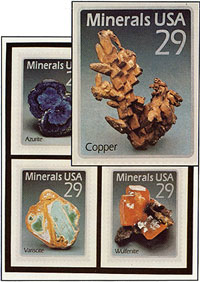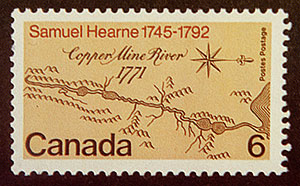Stamp of Approval for Copper
 Ever since England invented the postage stamp in 1840, nations have celebrated the great milestones of their industrial history on stamps. Thus copper, deservedly, has been commemorated by many nations through the years.
Ever since England invented the postage stamp in 1840, nations have celebrated the great milestones of their industrial history on stamps. Thus copper, deservedly, has been commemorated by many nations through the years.
The United States extended its first philatelic accolade to copper in September 1992 when it released a set of four mineral stamps. Besides the golden native copper ore, there is blue azurite, green variscate and orange red wulfenite. These stamps continue the "Mineral Heritage" series that began in 1977.
The artist who designed the copper stamp was Len Buckley of the Bureau of Engraving and Printing who based his designs on specimens from the Smithsonian National Museum of Natural History collection. The stamps were displayed in the museum's lobby through September 1992.
According to stamp expert Raymond Schuessler, copper deserves far more tribute than it has received on United States stamps. A larger, worldwide collection of copper stamps reveals the importance of this metal to many nations.
"Too often copper is considered for candlesticks or kettles without understanding the vast number of ways that copper serves in our advanced technology. The surge of electrical discoveries in the 19th century would not have been possible without copper. Every rocket, shuttle and satellite has a dependence on copper," Schuessler notes.
Canada, too, in September 1992, released a copper stamp in a set of minerals stamps commemorating the Geological Survey founded 150 years ago when Canada voted 1,500 pounds to create an organization to outline its geography. The specimen shown on the stamp comes from Kamloops, British Columbia.

This is not the first stamp Canada has issued to honor copper. On the bicentenary in 1971 of Samuel Hearne's expedition to the Copper Mine River in 1771, Canada printed a 6¢ stamp showing the original map of Copper River Basin.
Stamps have become such a repository for historical data that if archaeologists from some future civilization excavated a 20th century stamp collection, they would be able to deduce from it a history of the copper industry and its vital importance to our civilization.
The philatelist points out that man moved out of the Stone Age when he discovered the existence of copper perhaps after having accidentally built a fire on an exposed portion of a lode. Mining copper thus became one of man's first industries, heralding the Bronze Age. Easily hammered and shaped and alloyed into tools, utensils, ornaments and weapons, copper did more to advance the early ascent of man than any other element. It was the first metal to be used in any society and certainly one of the most important non-ferrous metals. "These are the kinds of achievements that stamps celebrate," he said.
Also in this Issue:
- Copper Outlasts Gold At Boston’s Old State House
- 3,000 Year-Old Copper/Bronze Statue On Display
- Copper Protects Doors and Windows from Salt Spray
- Copper Critical Element in Long-Lived Solar Heater
- Copper Brightens Homes
- Overcoming Water Shortages With Copper
- Stamp of Approval for Copper
